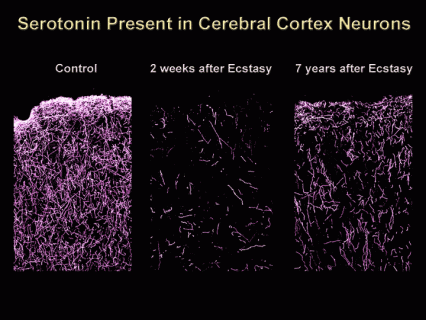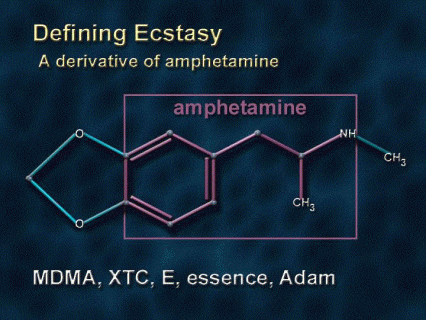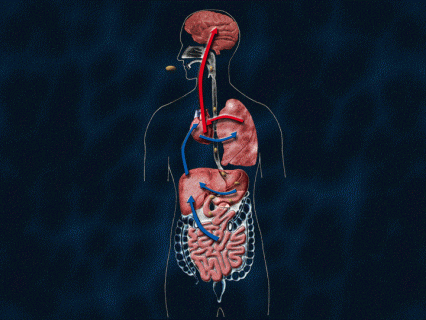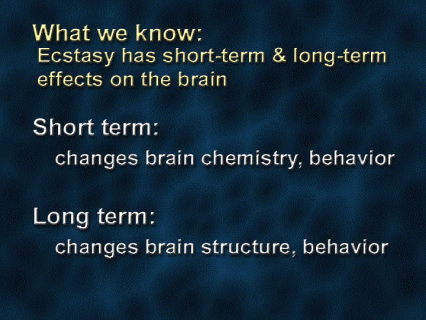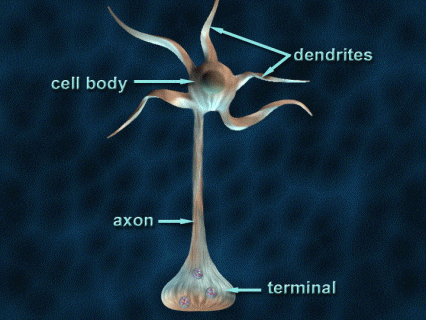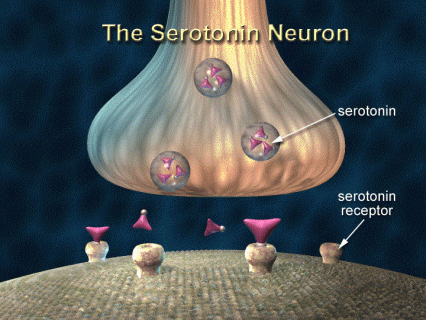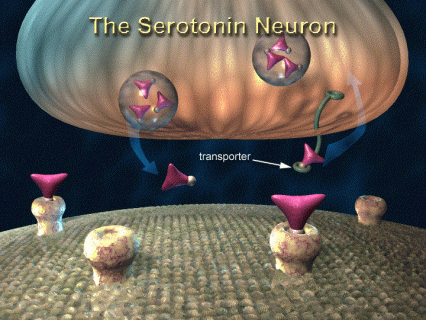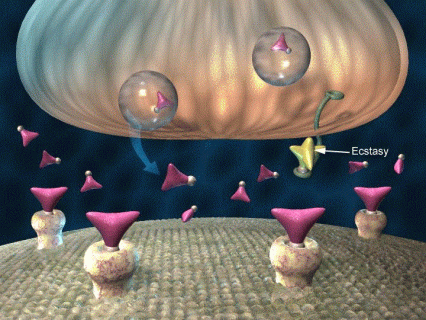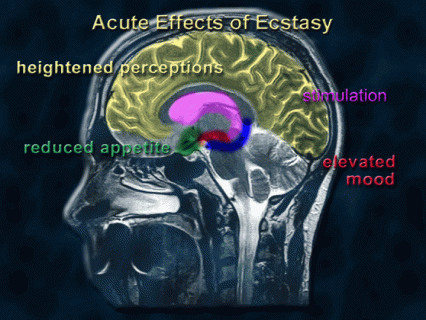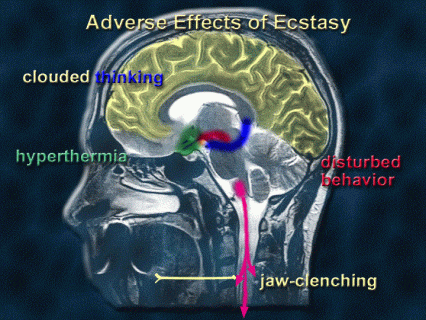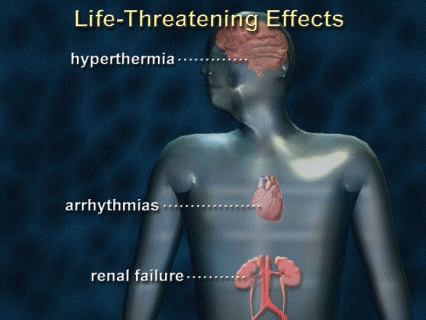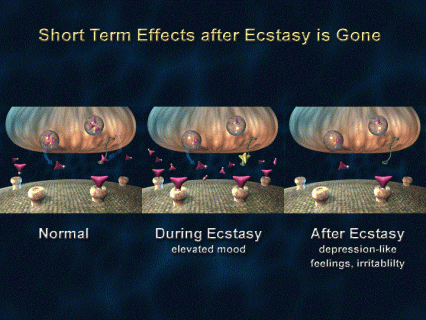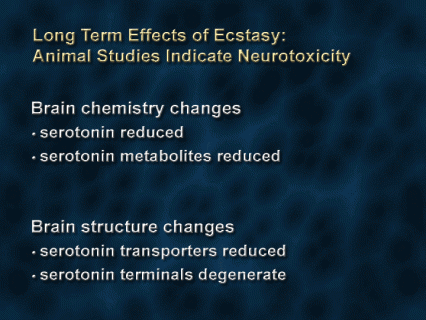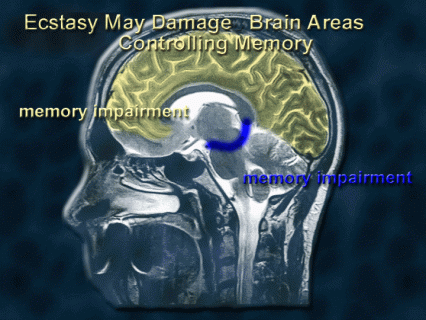The fourth in a 5-part series, explores the biology behind ecstasy use in the brain and discusses both short- and long-term effects of its use. This presentation can be downloaded as a Powerpoint file - The Neurobiology of Ecstasy (PPT, 7MB) and was last reviewed in January, 2007
- Introduction: long-term effects of ecstasy
-
An effective way of starting a presentation is to present something interesting or provocative. This first image shows sections taken from the neocortex of monkeys that were given ecstasy twice a day for 4 days (control monkeys were given saline). The section on the left, taken from the brain of a control monkey, shows the presence of a lot of serotonin. The middle section shows a section from a monkey two weeks after receiving ecstasy. Point out that most of the serotonin is gone. The section on the right shows a section from a monkey seven years after receiving ecstasy. Point out that although there has been some recovery of serotonin, the brain still has not returned to normal. Indicate that you will discuss this in your talk in more detail. Introduce the purpose of your presentation. Indicate that you will explain how ecstasy interacts with specific targets in the brain and what can happen after repeated or long-term use. Tell the students that you will review how neurons communicate with each other and how ecstasy alters this communication, resulting in changes in mood, behavior, and memory.
- Define ecstasy
-
Ecstasy is a derivative of amphetamine (shown in purple on the image). Its chemical name is 3,4-methylenedioxymethamphetamine (MDMA) and it has a similar structure to methamphetamine. ecstasy has a variety of street names including, XTC, Adam, M & M, E, and essence. Explain to students that ecstasy is unlike other drugs of abuse, which are often derived from plants (e.g., cocaine, morphine, nicotine). In contrast, ecstasy is synthesized in clandestine laboratories--in fact, there are several "designer drugs" that are made (in clandestine laboratories) by altering the structure of the amphetamine molecule. Because ecstasy is synthesized in laboratories, its purity can vary substantially from lab to lab, and other compounds are easily combined into the same tablet (contaminants often include caffeine, ephedrine, ketamine - a mild hallucinogen and methamphetamine).
- Ecstasy gets into the brain easily
-
The chemical structure of ecstasy allows it to reach the brain quickly after ingestion. Use the image to illustrate to the students the pathway that ecstasy follows from the mouth to the brain. First, the pill is ingested and it disintegrates quickly in the stomach contents. Once dissolved, some ecstasy molecules are absorbed from the stomach into the bloodstream, but most of the ecstasy molecules move from the stomach into the small intestine. There, they are absorbed into the bloodstream very easily.
The following explanation is optional and may be desirable for presentation to students who have had some chemistry: ecstasy is a weak base--this means that ecstasy is likely to "pick up" or accept a hydrogen ion (H+) from the surrounding medium (the gastric acid in the stomach is loaded with H+). After the ecstasy has accepted a H+, it has a charged (or polar) character, which makes it difficult to cross a biological membrane. Biological membranes have a nonpolar core, so compounds having a nonpolar nature are more likely to diffuse across the membrane (passive diffusion). Therefore, most of the ecstasy is not absorbed from the stomach into the bloodstream. Rather, the ecstasy molecules get emptied from the stomach into the small intestine. In the small intestine the more alkaline environment causes ecstasy to give up its H+, becoming more nonpolar. The large surface area and the more alkaline environment enable the ecstasy molecules to diffuse across the membrane into the blood capillaries very quickly.
Ecstasy molecules that have entered the bloodstream from the stomach and small intestines then travel to the liver (shown by the bottom blue arrows). In the liver, some of the ecstasy is metabolized to inactive compounds and the rest is carried through the veins to the heart (blue arrow). Once in the heart, the ecstasy is pumped to the lungs along with the blood, which becomes oxygenated and then returns to the heart (red arrow). Now, oxygenated blood carries the ecstasy from the heart to the brain (red arrow) and to other organs in body that have a high blood flow. Normally there is a barrier between the blood vessels in the brain and brain matter, which excludes many drugs from entering the brain. However, ecstasy is predominantly in its nonpolar form in blood and therefore it crosses the barrier into the brain very easily. It will take about 15 minutes for ecstasy to reach the brain if taken on an empty stomach.
- What we know about ecstasy
-
In recent years, there has been a lot of research carried out to understand how ecstasy affects the brain. Scientists have made a lot of progress in identifying how ecstasy changes mood and behavior. Indicate to students that ecstasy has short-term and long-term effects on the brain. The short-term effects of ecstasy include changes in brain chemistry and behavior. The long-term effects include changes in brain structure (based mainly on animal studies) and behavior. Tell them that you will try to illustrate how these changes take place. You could ask students if they have any knowledge of the short-term or long-term effects of ecstasy on the brain. If they volunteer some answers, list them on the board; indicate that you will discuss how some of these effects are produced.
- How do we know? Research in animals and humans
-
Bring up the importance of animals in research. Research in animals has provided us with a detailed understanding about the actions of ecstasy in the brain. In fact, many of the research findings obtained from animals, such as rats and monkeys, have now been replicated in humans. Indicate to the students that another important aspect of using animals in research is to understand mechanisms for toxicity produced by compounds. ecstasy is a classic example of a drug that produces toxicity (in the brain) and it would be impossible to study this in living humans. In the following set of images, the information highlighting how ecstasy works was obtained from research using animals.
- Brain areas sensitive to ecstasy
-
Before explaining how ecstasy works, it may be helpful to point out the areas of the brain that are sensitive to the effects of ecstasy. ecstasy affects cognition (thinking), mood, and memory. It also can cause anxiety and altered perceptions (similar to but not quite the same as hallucinations). The most desirable effect of ecstasy is its ability to provide feelings of warmth and empathy. Tell students that you will talk about the effects of ecstasy in more detail in a few minutes. There are several parts of the brain that are important in these actions of ecstasy. Point to the neocortex (in yellow), which is important in cognition, memory, and altered perceptions. Point to the several structures deep in the brain that make up the limbic system (e.g., the amygdala (red), hippocampus (blue), basal ganglia (purple), and hypothalamus (green), which is involved in changes in mood, emotions, and the production of anxiety (the hippocampus is also involved in memory). Scientists do not know yet which area of the brain is involved in the ability of ecstasy to generate feelings of empathy (you could ask students to suggest where they think ecstasy might do this - limbic areas are a good guess).
- Anatomy of a neuron
-
Now that the students know that there are specific regions of the brain affected by ecstasy, you will need to describe how it works. First, indicate that the different regions of the brain are connected by nerve cells or neurons via pathways. These pathways of neurons send and integrate information (electrical and chemical). Describe the neuron using the schematic in this image. The cell body, which contains the nucleus, is the center of activity. Dendrites receive chemical information from other neurons that is converted to electrical signals which travel toward the cell body. When the cell body receives enough electrical signals to excite it, a large electrical impulse is generated and it travels down the axon toward the terminal. In the terminal area, chemicals called neurotransmitters are released from the neuron in response to the arrival of an electrical signal. Tell the students that you will explain this in more detail, using the neurochemical serotonin as an example.
- How does ecstasy work: serotonin pathways in the brain
-
The nerve pathway that is predominantly affected by ecstasy is called the serotonin pathway. Serotonin is a neurotransmitter that is synthesized, stored, and released by specific neurons in this pathway. It is involved in the regulation of several processes within the brain, including mood, emotions, aggression, sleep, appetite, anxiety, memory, and perceptions. Tell the students that you will show them how a chemical like serotonin can regulate these processes. First, describe how serotonin pathways innervate (connect to) different brain regions. Point to the cell bodies of the serotonin pathway that are located in the brainstem area "the Raphe nucleus" in pink). Show students how these neurons send long axons to higher centers in the brain including the neocortex (yellow) and the limbic system (e.g., the amygdala--red and hippocampus--blue). Point to a second pathway for serotonin neurons that descends down the spinal cord; these neurons control muscle activity; tell the students that you will talk about this in more detail in a few minutes. Indicate that the function of serotonin depends on the region of the brain into which it is released (it also depends on the type of serotonin receptor present in that region--see discussion in image 9). For example, the serotonin neurons in the neocortex in the front of the brain (frontal cortex) regulate cognition, memory, and perceptions. The serotonin neurons in the hippocampus regulate memory. The serotonin neurons in other limbic areas such as the amygdala also regulate mood.
- The serotonin neuron: the major target of ecstasy
-
In order to help students understand how ecstasy affects the function of serotonin neurons, it will be useful to review how neurotransmission takes place in a little more detail. You can explain serotonin neurotransmission as an example (serotonin is one of many neurotransmitters). This image shows the connection between two neurons (the "synapse"). Serotonin is stored in small vesicles within the nerve terminal of a neuron. Electrical impulses (arising in the Raphe nucleus, for example) traveling down the axon toward the terminal cause the release of serotonin from small vesicles into the synaptic space. Point to the space between the terminal and the neighboring neuron. When in the synaptic space, the serotonin binds to special proteins, called receptors, on the membrane of a neighboring neuron (this is usually at a dendrite or cell body). When serotonin binds to serotonin receptors (there are actually at least 14 types of serotonin receptors), it causes a change in the electrical properties of the receiving neuron that generally results in a decrease in its firing rate. Go to the next image to explain how the action of serotonin is terminated.
- Serotonin transporters
-
Serotonin (in pink) is present in the synaptic space only for a limited amount of time. If it is not bound to the serotonin receptor, serotonin is removed from the synaptic space via special proteins called transporters (in green). The serotonin transporters are proteins located on the serotonin neuron terminals and they are in a unique position to transport serotonin from the synaptic space back into the neuron where it can be metabolized by enzymes. Explain to your students that the serotonin transporters are the primary targets for ecstasy.
- Ecstasy and serotonin transporters
-
When ecstasy binds to the serotonin transporters, more serotonin ends up in the synaptic space. This occurs for two reasons. First, ecstasy can prevent the transporters from carrying serotonin back into the terminal. Second, ecstasy can cause the transporters to work in reverse mode-- they actually bring serotonin from the terminal into the synaptic space. So, more serotonin is present in the synaptic space and more serotonin receptors become activated. This is the major short-term effect of ecstasy that alters brain chemistry. Although the serotonin system is the primary target for ecstasy, ecstasy has similar effects on the dopamine (another neurotransmitter) system as well. ecstasy can inhibit dopamine transporters and cause an increase in dopamine levels in the synaptic space (not shown here). To help students understand how the alteration in brain chemistry results in psychological changes, go to the next image.
- Short-term (acute) effects of ecstasy
-
Explain that when a person uses ecstasy, the increase in serotonin in different brain regions (i.e., the areas where serotonin neurons traveling from the raphe nucleus terminate) causes psychological effects. These include elevated mood and feelings of empathy. The ecstasy is also reinforcing, which means that its pleasurable properties increase the likelihood that the person will take it again. Tell the students that drugs that are reinforcing are usually addictive.
Students might ask you if ecstasy is addictive. Scientists and health professionals don't have a definitive answer yet. For now there are several pieces of evidence that suggest that ecstasy has the potential to be addictive. In one study of ecstasy users, 43% of respondents met criteria that are commonly used to determine dependence for other drugs of abuse. This included symptoms such as continuing to use the drug despite knowledge of physical or psychological harm, experiencing withdrawal effects, and tolerance (or diminished response) to repeated use of ecstasy. In a research setting, monkeys will administer ecstasy to themselves (they actually press a lever to obtain an injection), just as they do for other addictive drugs. Monkeys will not self-administer drugs that are not addictive. In addition, there is emerging research to show that ecstasy has actions in a specific pathway within the limbic system called the "reward pathway", which can explain it's reinforcing effects. In fact, all addictive drugs act in some way within the "reward pathway". For more information on this, see the NIDA Teaching Packet referenced at the end.
Many of the psychological effects of ecstasy are due to its actions within the limbic system (the amygdala, in red, and hippocampus, in blue, especially). The ability of ecstasy to produce mild stimulation is due to its actions in another part of the limbic system -- the basal ganglia (in purple). It is here where ecstasy's effects on the dopamine system may be important. The heightened perceptions involve the actions of ecstasy in the neocortex (in yellow). ecstasy can also reduce the appetite, because it acts in the hypothalamus (in green), which controls feeding behavior.
- Short-term adverse effects
-
People who take ecstasy desire its pleasurable or reinforcing effects (just described in the last image). However, few drugs are able to produce desirable effects without also producing side effects. ecstasy is no exception, and there are several side effects or adverse effects that can occur, especially at high doses. However, some people who take only one ecstasy pill may have negative psychological effects such as clouded thinking, agitation, and disturbed behavior. Point to areas of the brain where ecstasy may produce these adverse effects (the neocortex, in yellow and limbic structures, in red and blue). Other adverse effects can occur as well. These include sweating, dry mouth (thirsty), increased heart rate, fatigue, muscle spasms (especially jaw-clenching) and hyperthermia. In the latter case, ecstasy can disrupt the ability of the brain to regulate body temperature. This usually results in hyperthermia, especially when the user is in a hot environment and/or engaging in intense physical activity such as fast dancing at "rave" parties. You can provide some examples to show where ecstasy produces these side effects. For example, the development of thirst and the hyperthermia are due to actions of ecstasy in the hypothalamus (green), which controls drinking behavior and body temperature. You might point out that the effect of ecstasy on the hypothalamus causes multiple effects in the body, and in some cases they are very dangerous (see the next image). The muscle spasms and jaw-clenching are due to ecstasy's action at the motor neurons in the spinal cord (in yellow) (remind the students that a major serotonin pathway descends down the spinal cord). The motor neurons send signals to the muscles to contract.
- Life-threatening effects after multiple doses or stacking
-
Some people take multiple doses of ecstasy in one night ("stacking"). This might be due to the reinforcing effect of the drug wearing off over time. Often, if something feels good, one wants to do it again! Unfortunately, increased doses also increase the adverse effects, and some of these can become life-threatening. For example, repeated doses or a high dose of ecstasy can cause heat injury due to hyperthermia, hypertension (high blood pressure), cardiac arrhythmias (irregular heart beat), muscle breakdown and renal failure due to salt and fluid depletion. Indicate that these dangerous effects can be produced by ecstasy acting in the brain. Again, the hypothalamus is very important, because it regulates heart rate and blood pressure, fluid retention and kidney function and, of course, body temperature. If the body temperature gets too high, it can cause brain damage or even kill a person.
- Short-term effects after ecstasy is gone from the body
-
Ecstasy is an unusual drug because it has effects on the brain that develop and persist for a short time after the drug is eliminated from the body. These often include the development of depression-like feelings, anxiety, restlessness, irritability, and sleep disturbances. These "after effects" occur because of a chemical change that takes place at the serotonin synapse. To illustrate how this occurs, this image shows the serotonin synapse during and after taking ecstasy. Three conditions are illustrated: on the left, neurons normally release serotonin in response to electrical impulses (basically the release is in "spurts"). This results in the normal activation of serotonin receptors, which keeps our psychological and physiological function on an even keel. So, for example, we have a normal mood and we are calm. In the middle, ecstasy causes a sustained increase in the amount of serotonin in the synaptic space, leading to sustained activation of more serotonin receptors. This can produce an elevated mood (or euphoria). Eventually, the serotonin neurons can't make serotonin fast enough to replace that which was lost, so once Ecstasy is gone from the body (on the right), less serotonin is released with each electrical impulse and fewer serotonin receptors are activated, producing depression-like feelings and anxiety. Another important effect that may emerge after taking ecstasy is memory disruption. (Ask students if they can figure out which area of the brain is affected here; the answer should include the cerebral cortex and the hippocampus). This is an adverse effect that may persist with repeated or long-term use of ecstasy. Indicate to students that there is some evidence for this obtained from human studies.
- Long-term effects of ecstasy: neurotoxic?
-
When people use Ecstasy repeatedly or long term, there may be changes in their brain chemistry that suggest that the serotonin neurons are damaged. One major clue is that serotonin itself and its metabolites (remind students that serotonin that is taken back up into the terminal is metabolized by enzymes) are diminished in the brains of animals treated with ecstasy. Moreover, the best evidence that we have so far is that even seven years after a brief exposure to ecstasy, serotonin levels in monkey brains have not fully returned to normal. This is described in the next image.
- Long-term effects in monkeys
-
A very important experiment was performed in monkeys to determine if ecstasy can actually damage neurons. Monkeys were given ecstasy twice a day for four days (control monkeys were given saline). One group of monkeys' brains were removed two weeks later for analysis and another group of monkeys lived for an additional seven years before their brains were removed. Scientists examined the brains for the presence of serotonin. This image shows the presence of serotonin in neurons of the neocortex from three typical monkeys. On the left, the monkey who did not receive any ecstasy had a lot of serotonin (in pink) in the neocortex. Two weeks after a monkey received ecstasy, most of the serotonin was gone (point to the middle panel), suggesting that the serotonin neuron terminals were destroyed (there was no destruction of the serotonin cell bodies arising back in the brainstem). Point to the right-hand panel and show students that this damage appeared to be long-term because seven years later there was some recovery, but it was not complete. Scientists found similar changes in limbic areas of the brain such as the hippocampus and amygdala. The monkey experiments are an important reminder that humans may suffer the same fate, although this still remains to be demonstrated. Tell the students how difficult it is to do this same kind of experiment in humans, because it requires removing pieces of the brain to look for the loss of the serotonin neurons.
- Ecstasy causes degeneration of serotonin nerve terminals
-
This image illustrates the degeneration of serotonin nerve terminals after long-term or repeated use of ecstasy (you can refer back to image 9 to compare this degenerating terminal to a healthy terminal). Remind students that we have several pieces of evidence that support this effect of ecstasy. Experiments in animals given ecstasy indicate that this kind of degeneration occurs. Moreover, some studies of human ecstasy users report less serotonin and serotonin metabolites in the cerebrospinal fluid (which surrounds and bathes the brain and spinal cord) compared with nonusers. In contrast, the animal studies indicate that the serotonin cell bodies are still intact but the genetic instructions from the nucleus for any regrowth of the terminals may be abnormal.
Although scientists do not yet know for certain how ecstasy damages the serotonin terminals in these animal studies, some progress has been made in understanding this process. One mechanism is damage that involves the production of oxygen radicals (unstable forms of oxygen), which are very destructive to proteins, lipids, and DNA. The rich supply of mitochondria (which are a major source of oxygen radical formation) found in the terminals may cause the terminals to be especially sensitive to drugs like ecstasy.
- Long-term ecstasy use may impair memory
-
It is not possible to look directly at damaged serotonin terminals in living humans. The best evidence for damage to serotonin neurons after long-term or repeated Ecstasy use in humans is the association between the neurochemical and behavioral changes. Although many behavioral measures have been assessed in Ecstasy users (the list is extensive), the most consistent findings are that some chronic Ecstasy users have verbal and visual memory impairments. Research is ongoing to determine if thinking ability is disrupted as well. However, it is important to keep in mind that many users of Ecstasy may unknowingly be taking other drugs that are sold as Ecstasy, and/or they may intentionally use other drugs, such as marijuana, which may contribute to the observed deficits in memory. Additionally, most studies in people do not have measures of memory ability in Ecstasy users before they began taking drugs. Therefore, it is difficult to rule out pre-existing memory deficits in Ecstasy users compared to nonusers. Nevertheless, in some studies Ecstasy users who had memory impairments also had less serotonin metabolites or changes in other markers of serotonin function. In fact, several studies have shown that the degree of impairment or the changes in markers of serotonin function were related to the extent of Ecstasy use over the lifetime. On the image, point to the brain areas that are involved in the memory impairment - the neocortex (yellow) and the hippocampus (blue). [As an aside, you can tell students an interesting link between low serotonin and memory impairment: normal people who are fed a diet that causes them to synthesize less serotonin also have memory impairment.]

